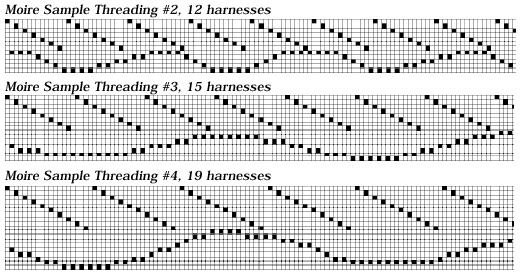Divided Designs
It is possible to independently
design two fabrics and then
combine their threadings, tie-ups,
treadlings (or peg plans) into a
single design and weave them as
a single fabric on a single loom.
The resulting weave structure
will, under certain circumstances,
retain some properties of
the original ones, and new (and
unusual) features are also likely
to appear.
This technique of combining two
separately-designed fabrics is
called a “divided design.”
The two designs at the bottom of
this page illustrate two such
separate fabrics. Note that each
design omits every other thread, a
convenience when subsequently
merging the designs. The fabric
on the left uses seven harnesses
while the one on the right uses
five harnesses.
The two designs are merged into
a single design by alternating
the threadings, putting the tie-ups
corner-to-corner, and using
the treadlings side-by-side. The
figure on the facing page shows
the resulting design.
Divided design fabrics can have
long floats once the merger is
completed. Use WeaveMaker’s
full-fabric float analysis tools to
detect and correct this problem.
Because the final fabric has to
be woven on a loom which has
as many harnesses as the sum
of the harnesses for the original
fabrics, creating interesting final
fabrics tends to require a high
harness count.


Moire Scheme
WeaveMaker has coordinated
threading, tie-up, and treadling
schemes, under the name Moire,
which create a divided design
fabric design (see the previous
page for a definition of “divided
design”).
Weaving elements appear here
for 12, 15, and 19 harnesses
(treadlings at right, tie-ups and
threadings below), and sample
fabrics created from them appear
below.





